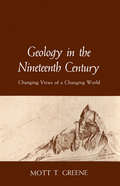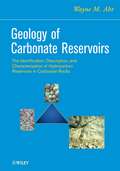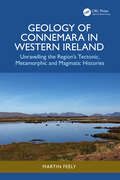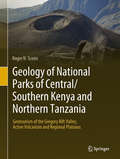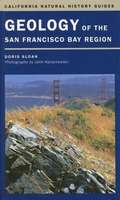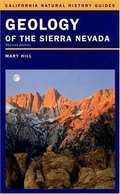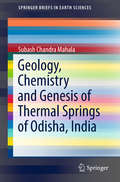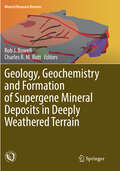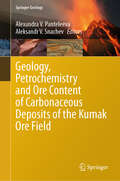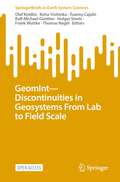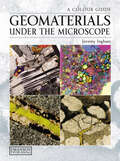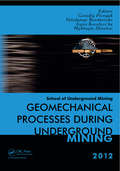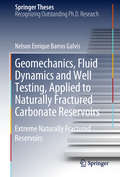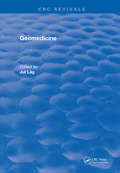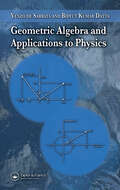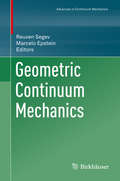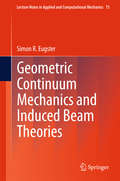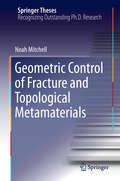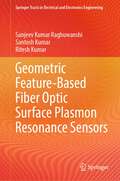- Table View
- List View
Geology in the Nineteenth Century: Changing Views of a Changing World
by Mott T. GreeneIn this clear and comprehensive introduction to developments in geological theory during the nineteenth century, Mott T. Greene asserts that the standard accounts of nineteenth-century geology, which dwell on the work of Anglo-American scientists, have obscured the important contributions of Continental geologists; he balances this traditional emphasis with a close study of the innovations of the French, German, Austro-Hungarian, and Swiss geologists whose comprehensive theory of earth history actually dominated geological thought of the time. Greene's account of the Continental scientists places the history of geology in a new light: it demonstrates that scientific interest in the late nineteenth century shifted from uniform and steady processes to periodic and cyclic events—rather than the other way around, as the Anglo-American view has represented it. He also puts continental drift theory in its context, showing that it was not a revolutionary idea but one that emerged naturally from the Continental geologists' foremost subject of study-the origin of mountains, oceans, and continents. A careful inquiry into the nature of geology as a field poised between natural history and physical science, Geology in the Nineteenth Century will interest students and scholars of geology, geophysics, and geography as well as intellectual historians and historians of science.
Geology of Carbonate Reservoirs
by Wayne M. AhrAn accessible resource, covering the fundamentals of carbonate reservoir engineeringIncludes discussions on how, where and why carbonate are formed, plus reviews of basic sedimentological and stratigraphic principles to explain carbonate platform characteristics and stratigraphic relationshipsOffers a new, genetic classification of carbonate porosity that is especially useful in predicting spatial distribution of pore networks.Includes a solution manual
Geology of Connemara in Western Ireland: Unravelling the Region’s Tectonic, Metamorphic, and Magmatic Histories
by Martin FeelyThe Connemara region in Western Ireland is world-renowned for its outstanding geology that is blended with spectacular landscapes. This book and its many colourful illustrations, maps, diagrams, field and landscape images detail the origin and formation of Connemara’s metamorphic and igneous rocks in deep time from 700 to 380 million years ago. It combines many field geology observations and current research results, and describes the many geological processes involved in the formation of the bedrock foundations of Connemara: plate tectonics, granite magmatism, deformation, metamorphism and mineral deposits. An amazing book for students and geological societies that visit the region annually.Features The only book available on the formation of the igneous and metamorphic rock complexes in Connemara Explores the regional geological context of Connemara from ~700 Ma to 385 Ma Incorporates the most up-to-date research results and many useful field images, maps and schematic diagrams for teacher and student alike Describes the deformation, metamorphic and magmatic histories in Pressure-Temperature-time (PTt) space Includes a chapter dedicated to the application of fluid inclusion studies to magmatic and hydrothermal mineralization in the Galway Granite Complex and its environs This book serves as a resource for professionals, academics and senior undergraduate and graduate students working and studying in the fields of geology, earth sciences and environmental sciences.
Geology of National Parks of Central/Southern Kenya and Northern Tanzania: Geotourism Of The Gregory Rift Valley, Active Volcanism And Regional Plateaus
by Roger N. ScoonThis book describes the interrelationship between the spectacular geology of an area of East Africa that includes a branch of the rift valley, as well as giant freestanding ice-capped mountains and extraordinarily toxic, alkaline lakes, and some of the greatest concentrations of wildlife on Earth. It suggests that geological processes that have shaped the iconic landforms, including active volcanoes, may also be responsible for the unusually diverse speciation which characterises the region. Moreover, it is not a coincidence that important palaeoanthropological discoveries have been unearthed in the region. National parks and conservation areas have tremendous potential for geotourism and the book assists both tour guides and visitors in this regard. In addition, the book may provide a better understanding to management of the importance of geology for sustaining wildlife.
Geology of the Great Plains and Mountain West
by Cynthia Light BrownAnswering intriguing questions such as Why does the largest river system in North America meander across the middle of the continent? and How does such a system relate to the rugged Rocky Mountains?, this fun-filled book delves into the majestic Great Plains region. The chapters concisely clarify the interrelated subjects of terrain, climate, and the great movements of the earth itself while illustrating the important changes that are still occurring in the area's rivers, lakes, plains, and unpredictable weather. Brimming with fascinating facts, educational sidebars tell how earthquakes in New Madrid, Missouri caused waves to go upstream in the Mississippi River; why and how tornadoes form; and how invasive species are threatening the Great Lakes and what people are doing about it.
Geology of the San Francisco Bay Region (California Natural History Guides)
by Doris SloanThis book is for San Francisco Bay Area residents and visitors who want to explore the geologic world of this spectacular area, to learn about its shapes, colors, and rocky foundations. Doris Sloan illuminates the colorful geologic mosaic that surrounds San Francisco Bay and lucidly explains the complex and fascinating processes that have forged it over millions of years.
Geology of the Sierra Nevada (Revised Edition)
by Mary HillThe author introduces the rocks of the Sierra Nevada, which tell the mountains' tale, and explains how nature's forces, such as volcanic eruptions, earthquakes, faulting, erosion, and glaciation formed the range's world-renowned scenery and mineral wealth, including gold.
Geology, Chemistry and Genesis of Thermal Springs of Odisha, India (Springerbriefs In Earth Sciences Ser.)
by Subash Chandra MahalaThis book presents a comprehensive overview of the nature of manifestation and general aspects of thermal springs of Odisha. A detailed description of geological formations and the relationship between tectonic settings with thermal spring emanation is given for better understanding of the geothermal system. Physico-chemical characteristics of water and gas have been studied and interpreted to ascertain the nature and source of geothermal fluid and to generate a conceptual model on the origin. The book can serve as a valuable reference for earth scientists, planners and researchers in the field of geothermal energy. As the thermal springs are spectacular sites for tourists this illustrated book can also help tourists, tourist guides and tourism departments.
Geology, Geochemistry and Formation of Supergene Mineral Deposits in Deeply Weathered Terrain (Mineral Resource Reviews)
by Rob J. Bowell Charles R. M. ButtThis book provides a comprehensive overview of the major supergene mineral deposits formed in intensely weathered lateritic terrains. It discusses both contemporary and pre-existing supergene deposits, describing their geological, mineralogical and geochemical characteristics. Supergene processes of enrichment are those that occur under ambient near-surface conditions, compared to hypogene processes mostly at depth under higher temperatures and pressures. Supergene processes include the predominance of meteoric water circulation with concomitant oxidation and chemical weathering. Descending meteoric waters oxidize the primary (hypogene) minerals and redistribute the chemical elements. Residual supergene enrichment occurs as a physical process when the predominant rock-forming minerals oxidize and dissolve, concentrating ore elements hosted in resistant stable minerals; absolute chemical enrichment occurs when the ore elements themselves are leached and migrate in groundwater and precipitate due changes in the pH, oxidation potential and chemical composition of water. These processes can enrich commercially important elements to produce orebodies formed entirely by supergene processes. These include Al (bauxite), Fe ore, Ni-Co laterites, kaolinite, REE (clay deposits), Nb and REE (on carbonatites), base metals (secondary <span class="
Geology, Geography, and Climate (North Dakota Studies)
by Gwyn S. Herman Laverne A. JohnsonThis book is filled with interesting and useful information about the geology, geography, and climate of North Dakota. Through reading and engaging in the variety of activities that accompany this text, you will find this journey of discovery to be enjoyable and exciting! What was North Dakota like before there was a North Dakota? What happened to make North Dakota what it is today? Why is North Dakota such a special place?
Geology, Petrochemistry and Ore Content of Carbonaceous Deposits of the Kumak Ore Field (Springer Geology)
by Alexandra V. Panteleeva Aleksandr V. SnachevThe main prospects for expanding the mineral resource base of gold are associated with the discovery of typical ore objects within the distribution of productive black shale strata in the Orenburg part of the Southern Urals. The solution of this problem is significantly associated with the discovery, evaluation and involvement in the industrial development of gold deposits lying in the black shale strata. Their practical significance, based on existing concepts, can be considered in several aspects: first of all, it is a possible source of metals, and secondly, they are a reducing geochemical barrier for the deposition of ore matter of deep fluids. The formations of the black shale formation are a favorable geochemical environment for the primary concentration of gold, platinum group elements, tungsten, molybdenum and other metals. Areas of manifestation of tectonic activity, zonal and contact metamorphism, and the dyke complex are of great importance. Moreover, carbonaceous deposits are a very informative material for the reconstruction of paleogeographic and physico-chemical conditions of their accumulation. In this regard, the ore-containing black shales of the Kumak deposit, whose rocks have a specialization in gold, seem to be a very attractive object for a comprehensive study of ore content. They may be of great practical importance for the search for new deposits in the Southern Urals and in other regions with a similar geological structure.
Geology: Reader (Amplify Core Knowledge Language Arts, Grade 4 #Unit 5)
by Amplify EducationNIMAC-sourced textbook
GeomInt—Discontinuities in Geosystems From Lab to Field Scale (SpringerBriefs in Earth System Sciences)
by Thomas Nagel Olaf Kolditz Frank Wuttke Holger Steeb Keita Yoshioka Tuanny Cajuhi Ralf-Michael GüntherThis is an open access book. In view of growing conflicts over strategic georesources, the use of the geological subsurface in the sense of a regional resource is becoming increasingly important. In this context, georeservoirs are playing an important role for the energy transition not only as a source of energy but also as a storage facility and deep geological disposal for energy waste. The success of the energy transition also depends to a large extent on the efficient and safe use of underground resources.This book complements the previous basic book (GeomInt—Integrity of Host Rocks) with a series of application examples in different rock formations, clay, salt, and crystalline. The methodology developed in GeomInt is used, among others, in the Mont Terri underground research laboratory (Opalinus Clay), in the large borehole test in Springen (salt rock) and in the “Reiche Zeche” teaching and research mine (crystalline rock). In addition, new methodological developments are also taken up in experiments and models and embedded in workflows for geotechnical system analyses. The present book summarizes the results of the collaborative project “GeomInt2: Geomechanical integrity of host and barrier rocks - experiment, modeling and analysis of discontinuities” within the program: Geo Research for Sustainability (GEO: N) of the Federal Ministry of Education and Research (BMBF).
Geomaterials Under the Microscope: A Colour Guide
by Jeremy InghamThe first comprehensive guide to the petrography of geomaterials, making the petrographers specialist knowledge available to practitioners, educators and students worldwide interested in modern and historic construction materials.
Geomechanical Processes during Underground Mining: School of Underground Mining 2012
by Genadiy Pivnyak Volodymyr Bondarenko Iryna Kovalevs'Ka Mykhaylo IlliashovThis volume deals with economic aspects of mining companies development strategies, various mineral deposits development techniques, imitational modeling of mine workings with rock massif, methane extraction technologies during coal mining, geomechanical processes during plow mining, mining transport importance for mineral extraction, massif
Geomechanics of Oil and Gas Wells (Advances in Oil and Gas Exploration & Production)
by Vladimir Karev Yuri Kovalenko Konstantin UstinovThe book presents an integrated approach to studying the geomechanical processes occurring in oil and gas-bearing formations during their development. It discusses the choice of a model that takes into account the basic properties of rocks; experiments to find model parameters; numerical modeling; and direct physical modeling of deformation and filtration processes in reservoir and host rocks. Taking into account features of rock behavior, such as anisotropy of the mechanical properties of rocks during elastoplastic deformation; dependence of permeability on the total stress tensor; the contribution of the filtration flow to the formation stress state; and the influence of tangential as well as normal stresses on the transition to inelastic deformation, it demonstrates how the presented approach allows the practical problems of increasing the productivity of wells, oil recovery, and ensuring the stability of wellbores to be solved.The book is intended for specialists, including geoengineers working in the oil and gas sector, teachers, graduate students and students, as well as all those interested in scientific and technological developments to meet the enormous demand for raw materials and energy.
Geomechanics, Fluid Dynamics and Well Testing, Applied to Naturally Fractured Carbonate Reservoirs
by Nelson Enrique Barros GalvisThis thesis presents an important step towards a deeper understanding of naturally fractured carbonate reservoirs (NFCRs). It demonstrates the various kinds of discontinuities using geological evidence, mathematical kinematics model and computed tomography and uses this as a basis for proposing a new classification for NFCRs. Additionally, this study takes advantage of rock mechanics theory to illustrate how natural fractures can collapse due to fluid flow and pressure changes in the fractured media. The explanations and mathematical modeling developed in this dissertation can be used as diagnostic tools to predict fluid velocity, fluid flow, tectonic fracture collapse, pressure behavior during reservoir depleting, considering stress-sensitive and non-stress-sensitive, with nonlinear terms in the diffusivity equation applied to NFCRs. Furthermore, the book presents the description of real reservoirs with their field data as the principal goal in the mathematical description of the realistic phenomenology of NFCRs.
Geomedicine (CRC Press Revivals)
by Jul LagThis fascinating work features such topics as the relationships between iodine deficiency and goiter, fluorine deficiency and caries, selenium deficiency and muscular degeneration, mercury surplus and specific nerve diseases, cadmium surplus and kidney failure. This one-of-a-kind volume reveals discoveries which may be of importance in future preventive medicine for man and animals. It shows that the comprehensive progress in chemical analyses has established a valuable basis for determining many environmental features and for the foundation of modern geomedicine. Those involved with geology, soil science, nutrition, biology, veterinary sciences, and prophylactic socio-medical sciences will find this resource indispensable.
Geometric Algebra Applications Vol. III: Integral Transforms, Machine Learning, and Quantum Computing
by Eduardo Bayro-CorrochanoThe goal of Geometric Algebra Applications Vol. III: Integral Transforms, Machine Learning, and Quantum Computing is to present a unified mathematical treatment of diverse problems in the general domain like Clifford Fourier Transforms, Deep Learning and Geometric Algebra Convolutional Neural Networks, Quaternion Quantum Fourier Transform and Geometric Quantum Computing. Topics and features · Introduces nonspecialists to Clifford, or geometric algebra and by example encourages the reader to learn to compute using geometric entities and geometric formulations. · A study in depth for applications of Lie group theory, Lie algebra, projective geometry, and the algebra of incidence using the conformal geometric algebra. · Features the computing frameworks of the linear model n-dimensional affine plane and the nonlinear model of Euclidean space known as the horosphere, and addresses the relationships of these models to conformal, affine, and projective geometries. · Includes a thorough study of Integral transforms: Quaternion and Clifford Transforms, quaternion analytic signal, monogenic signals, Hilbert transform, Riesz transform, Clifford Fourier Transform, Quaternion Wavelet transforms, Quaternion Quantum Fourier Transform, 3D Radon Transform and Hough-Transform in geometric algebra. · Color image processing using the color model HSV, Quaternion Split rotors and motors, and the space-time Lorentz transform. · Geometric neural computing using Split Quaternions, Geometric Algebra neural networks, Clifford Support Vector Machine and Neuro Control. · Thorough discussion of several tasks of computer vision, graphics, neurocomputing, and robotics. machine learning, Deep Learning and CNNs, and Geometric Quantum Computing using the geometric algebra framework. · 130 exercises and hints for the development of future computer software packages for extensive calculations in geometric algebra. An entire section is dedicated to explaining how one should write the subroutines in C++, Phyton, Matlab, and Maple to carry out efficient geometric computations in the geometric algebra framework. Furthermore, it is shown how program code can be optimized for real-time computations. The book is an essential resource for applied mathematicians, physicists, computer scientists, graphics engineering, AI and Machine Learning researchers, roboticists and mechanical and electrical engineers, neurocomputing researchers, neuroscientists, and quantum computing specialists. It clarifies and demonstrates the importance of geometric computing for building autonomous systems and pushes forward advances in geometric cybernetics research.
Geometric Algebra and Applications to Physics
by Venzo de Sabbata Bidyut Kumar DattaBringing geometric algebra to the mainstream of physics pedagogy, Geometric Algebra and Applications to Physics not only presents geometric algebra as a discipline within mathematical physics, but the book also shows how geometric algebra can be applied to numerous fundamental problems in physics, especially in experimental situations. This
Geometric Continuum Mechanics (Advances in Mechanics and Mathematics #42)
by Marcelo Epstein Reuven SegevThis contributed volume explores the applications of various topics in modern differential geometry to the foundations of continuum mechanics. In particular, the contributors use notions from areas such as global analysis, algebraic topology, and geometric measure theory. Chapter authors are experts in their respective areas, and provide important insights from the most recent research. Organized into two parts, the book first covers kinematics, forces, and stress theory, and then addresses defects, uniformity, and homogeneity. Specific topics covered include:Global stress and hyper-stress theoriesApplications of de Rham currents to singular dislocationsManifolds of mappings for continuum mechanicsKinematics of defects in solid crystalsGeometric Continuum Mechanics will appeal to graduate students and researchers in the fields of mechanics, physics, and engineering who seek a more rigorous mathematical understanding of the area. Mathematicians interested in applications of analysis and geometry will also find the topics covered here of interest.
Geometric Continuum Mechanics and Induced Beam Theories
by Simon R. EugsterThis research monograph discusses novel approaches to geometric continuum mechanics and introduces beams as constraint continuous bodies. In the coordinate free and metric independent geometric formulation of continuum mechanics as well as for beam theories, the principle of virtual work serves as the fundamental principle of mechanics. Based on the perception of analytical mechanics that forces of a mechanical system are defined as dual quantities to the kinematical description, the virtual work approach is a systematic way to treat arbitrary mechanical systems. Whereas this methodology is very convenient to formulate induced beam theories, it is essential in geometric continuum mechanics when the assumptions on the physical space are relaxed and the space is modeled as a smooth manifold. The book addresses researcher and graduate students in engineering and mathematics interested in recent developments of a geometric formulation of continuum mechanics and a hierarchical development of induced beam theories.
Geometric Control of Fracture and Topological Metamaterials (Springer Theses)
by Noah MitchellThis thesis reports a rare combination of experiment and theory on the role of geometry in materials science. It is built on two significant findings: that curvature can be used to guide crack paths in a predictive way, and that protected topological order can exist in amorphous materials. In each, the underlying geometry controls the elastic behavior of quasi-2D materials, enabling the control of crack propagation in elastic sheets and the control of unidirectional waves traveling at the boundary of metamaterials. The thesis examines the consequences of this geometric control in a range of materials spanning many orders of magnitude in length scale, from amorphous macroscopic networks and elastic continua to nanoscale lattices.
Geometric Feature-Based Fiber Optic Surface Plasmon Resonance Sensors (Springer Tracts in Electrical and Electronics Engineering)
by Santosh Kumar Sanjeev Kumar Raghuwanshi Ritesh KumarThis book focuses on the surface plasmon resonance (SPR) technique covering fibre optic sensor research. It highlights recent advancements in geometric feature-based fibre optic SPR sensors for chemical/biochemical/biosensor applications. The contents also discuss the principle of the SPR sensing technique as well as various designs of fibre optic SPR probes for improving sensor sensitivity. It also includes numerous examples of SPR-based fibre optic sensors with various geometric (such as U-type, taper type, D-type, and interferometric-based) sensors. This volume will be a useful reference to those in academia and industry especially researchers with useful information focusing on fibre optic SPR sensors.
